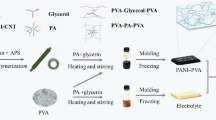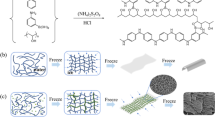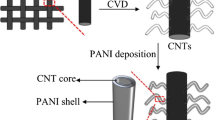Abstract
Porous polyaniline (PANI) was prepared through an efficient and cost-effective method by polymerization of aniline in the NaCl solution at room temperature. The resulting PANI provided large surface area due to its highly porous structure and the intercrossed nanorod, resulting in good electrochemical performance. The porous PANI electrodes showed a high specific capacitance of 480 F·g−1, 3 times greater than that of PANI without using the NaCl solution. We also make chemically crosslinked hydrogel film for hydrogel polymer electrolyte as well as the flexible supercapacitors (SCs) with PANI. The specific capacitance of the device was 234 F·g−1 at the current density of 1 A·g−1. The energy density of the device could reach as high as 75 W·h·kg−1 while the power density was 0.5 kW·kg−1, indicating that PANI be a promising material in flexible SCs.
Similar content being viewed by others
References
Huang Y, Tang Z, Liu Z, et al. Toward enhancing wearability and fashion of wearable supercapacitor with modified polyurethane artificial leather electrolyte. Nano-Micro Letters, 2018, 10(3): 38
Pei Z, Hu H, Liang G, et al. Carbon-based flexible and all-solidstate micro-supercapacitors fabricated by inkjet printing with enhanced performance. Nano-Micro Letters, 2017, 9(2): 19
Dominic J, David T, Vanaja A, et al. Supercapacitor performance study of lithium chloride doped polyaniline. Applied Surface Science, 2018, 460: 40–47
Li S, Zhang N, Zhou H, et al. An all-in-one material with excellent electrical double-layer capacitance and pseudocapacitance performances for supercapacitor. Applied Surface Science, 2018, 453: 63–72
Ren X, Fan H, Ma J, et al. Hierarchical Co3O4/PANI hollow nanocages: Synthesis and application for electrode materials of supercapacitors. Applied Surface Science, 2018, 441: 194–203
Peng X, Peng L, Wu C, et al. Two dimensional nanomaterials for flexible supercapacitors. Chemical Society Reviews, 2014, 43(10): 3303–3323
Tobjörk D, Österbacka R. Paper electronics. Advanced Materials, 2011, 23(17): 1935–1961
Huang J, Wang K, Wei Z. Conducting polymer nanowire arrays with enhanced electrochemical performance. Journal of Materials Chemistry, 2010, 20(6): 1117–1121
Lu X, Yu M, Wang G, et al. Flexible solid-state supercapacitors: design, fabrication and applications. Energy & Environmental Science, 2014, 7(7): 2160–2181
Cong H P, Ren X C, Wang P, et al. Flexible graphene-polyaniline composite paper for high-performance supercapacitor. Energy & Environmental Science, 2013, 6(4): 1185–1191
Xu J, Wang K, Zu S Z, et al. Hierarchical nanocomposites of polyaniline nanowire arrays on graphene oxide sheets with synergistic effect for energy storage. ACS Nano, 2010, 4(9): 5019–5026
Bhadra S, Khastgir D, Singha N K, et al. Progress in preparation, processing and applications of polyaniline. Progress in Polymer Science, 2009, 34(8): 783–810
Chiou N R, Epstein A J. Polyaniline nanofibers prepared by dilute polymerization. Advanced Materials, 2005, 17(13): 1679–1683
Li D, Huang J, Kaner R B. Polyaniline nanofibers: a unique polymer nanostructure for versatile applications. Accounts of Chemical Research, 2009, 42(1): 135–145
Wang Y, Shi Y, Pan L, et al. Dopant-enabled supramolecular approach for controlled synthesis of nanostructured conductive polymer hydrogels. Nano Letters, 2015, 15(11): 7736–7741
Pan L, Yu G, Zhai D, et al. Hierarchical nanostructured conducting polymer hydrogel with high electrochemical activity. Proceedings of the National Academy of Sciences of the United States of America, 2012, 109(24): 9287–9292
Tong Y, Huang W, Luo J, et al. Synthesis and properties of aromatic polyimides derived from 2,2,′3,3′-biphenyltetracarboxylic dianhydride. Journal of Polymer Science Part A: Polymer Chemistry, 1999, 37(10): 1425–1433
Tavandashti N P, Ghorbani M, Shojaei A. Controlled growth of hollow polyaniline structures: From nanotubes to microspheres. Polymer, 2013, 54(21): 5586–5594
Zhang X, Zhu J, Haldolaarachchige N, et al. Synthetic process engineered polyaniline nanostructures with tunable morphology and physical properties. Polymer, 2012, 53(10): 2109–2120
Amarnath C A, Kim J, Kim K, et al. Nanoflakes to nanorods and nanospheres transition of selenious acid doped polyaniline. Polymer, 2008, 49(2): 432–437
Miao Y E, Fan W, Chen D, et al. High-performance supercapacitors based on hollow polyaniline nanofibers by electrospinning. Applied Materials & Interfaces, 2013, 5(10): 4423–4428
Kobayashi S, Uyama H, Kimura S. Enzymatic polymerization. Chemical Reviews, 2001, 101(12): 3793–3818
Gao H, Lian K. Proton-conducting polymer electrolytes and their applications in solid supercapacitors: a review. RSC Advances, 2014, 4(62): 33091–33113
Guiseppi-Elie A. Electroconductive hydrogels: synthesis, characterization and biomedical applications. Biomaterials, 2010, 31(10): 2701–2716
Choudhury N A, Sampath S, Shukla A K. Hydrogel-polymer electrolytes for electrochemical capacitors: an overview. Energy & Environmental Science, 2009, 2: 55–67
Topinka M A, Rowell M W, Goldhaber-Gordon D, et al. Charge transport in interpenetrating networks of semiconducting and metallic carbon nanotubes. Nano Letters, 2009, 9(5): 1866–1871
Yuan L, Lu X H, **ao X, et al. Flexible solid-state supercapacitors based on carbon nanoparticles/MnO2 nanorods hybrid structure. ACS Nano, 2012, 6(1): 656–661
Lu X, Zeng Y, Yu M, et al. Oxygen-deficient hematite nanorods as high-performance and novel negative electrodes for flexible asymmetric supercapacitors. Advanced Materials, 2014, 26(19): 3148–3155
Son D, Lee J, Qiao S, et al. Multifunctional wearable devices for diagnosis and therapy of movement disorders. Nature Nanotechnology, 2014, 9(5): 397–404
Asturias-Soberanis G E. Oxidative and polymeric acid do** of polyaniline and related Donnan phenomena. General Information, 1992
Chao D, Chen J, Lu X, et al. SEM study of the morphology of high molecular weight polyaniline. Synthetic Metals, 2005, 150(1): 47–51
Cho S, Hwang S H, Kim C, et al. Polyaniline porous counter-electrodes for high performance dye-sensitized solar cells. Journal of Materials Chemistry, 2012, 22(24): 12164–12171
Epstein A J, Ginder J M, Zuo F, et al. Insulator-to-metal transition in polyaniline: Effect of protonation in emeraldine. Synthetic Metals, 1987, 21(1–3): 63–70
Germain J, Fréchet J M J, Svec F. Hypercrosslinked polyanilines with nanoporous structure and high surface area: potential adsorbents for hydrogen storage. Journal of Materials Chemistry, 2007, 17(47): 4989–4997
Li G, Zhang Z. Synthesis of dendritic polyaniline nanofibers in a surfactant gel. Macromolecules, 2004, 37(8): 2683–2685
Hassan P A, Sawant S N, Bagkar N C, et al. Polyaniline nanoparticles prepared in rodlike micelles. Langmuir, 2004, 20(12): 4874–4880
Laridjani M, Pouget J P, Scherr E M, et al. Amorphography — the relationship between amorphous and crystalline order. 1. The structural origin of memory effects in polyaniline. Macromolecules, 1992, 25(16): 4106–4113
Liu J, Zhou M, Fan L Z, et al. Porous polyaniline exhibits highly enhanced electrochemical capacitance performance. Electrochimica Acta, 2010, 55(20): 5819–5822
Niziol J, Gondek E, Plucinski K J. Characterization of solution and solid state properties of polyaniline processed from trifluoroacetic acid. Journal of Materials Science: Materials in Electronics, 2012, 23(12): 2194–2201
Anu Prathap M U, Thakur B, Sawant S N, et al. Synthesis of mesostructured polyaniline using mixed surfactants, anionic sodium dodecylsulfate and non-ionic polymers and their applications in H2O2 and glucose sensing. Colloids and Surfaces B: Biointerfaces, 2012, 89: 108–116
Tagowska M, Palys B, Jackowska K. Polyaniline nanotubules — anion effect on conformation and oxidation state of polyaniline studied by Raman spectroscopy. Synthetic Metals, 2004, 142(1–3): 223–229
Wei D, Kvarnström C, Lindfors T, et al. Polyaniline nanotubules obtained in room-temperature ionic liquids. Electrochemistry Communications, 2006, 8(10): 1563–1566
Anbalagan A C, Sawant S N. Brine solution-driven synthesis of porous polyaniline for supercapacitor electrode application. Polymer, 2016, 87: 129–137
Wei Z, Zhang Z, Wan M. Formation mechanism ofself-assembled polyaniline micro/nanotubes. Langmuir, 2002, 18(3): 917–921
Cho S, Shin K H, Jang J. Enhanced electrochemical performance of highly porous supercapacitor electrodes based on solution processed polyaniline thin films. Applied Materials & Interfaces, 2013, 5(18): 9186–9193
Chen J, Wang H, Deng J, et al. Low-crystalline tungsten trioxide anode with superior electrochemical performance for flexible solid-state asymmetry supercapacitor. Journal of Materials Chemistry A: Materials for Energy and Sustainability, 2018, 6(19): 8986–8991
Yang J, Yu C, Liang S, et al. Bridging of ultrathin NiCo2O4 nanosheets and graphene with polyaniline: a theoretical and experimental study. Chemistry of Materials, 2016, 28(16): 5855–5863
Amarnath C A, Chang J H, Kim D, et al. Electrochemical supercapacitor application ofelectroless surface polymerization of polyaniline nanostructures. Materials Chemistry and Physics, 2009, 113(1): 14–17
Devan S, Subramanian V R, White R E. Analytical solution for the impedance of a porous electrode. Journal of the Electrochemical Society, 2004, 151(6): A905–A913
Sumboja A, Wang X, Yan J, et al. Nanoarchitectured current collector for high rate capability of polyaniline based supercapacitor electrode. Electrochimica Acta, 2012, 65: 190–195
Tang Q, Chen M, Wang G, et al. A facile prestrain-stick-release assembly of stretchable supercapacitors based on highly stretchable and sticky hydrogel electrolyte. Journal of Power Sources, 2015, 284: 400–408
Tang Q, Chen M, Wang L, et al. A novel asymmetric supercapacitors based on binder-free carbon fiber paper@nickel cobaltite nanowires and graphene foam electrodes. Journal of Power Sources, 2015, 273: 654–662
Tang Q, Wang W, Wang G. The perfect matching between the low-cost Fe2O3 nanowire anode and the NiO nanoflake cathode significantly enhances the energy density of asymmetric supercapacitors. Journal of Materials Chemistry A: Materials for Energy and Sustainability, 2015, 3(12): 6662–6670
Choudhury N A, Shukla A K, Sampath S, et al. Cross-linked polymer hydrogel electrolytes for electrochemical capacitors. Journal of the Electrochemical Society, 2006, 153(3): A614–A620
Li H, He Y, Pavlinek V, et al. MnO2 nanoflake/polyaniline nanorod hybrid nanostructures on graphene paper for high-performance flexible supercapacitor electrodes. Journal of Materials Chemistry A: Materials for Energy and Sustainability, 2015, 3(33): 17165–17171
Zhao J, Lai H, Lyu Z, et al. Hydrophilic hierarchical nitrogen-doped carbon nanocages for ultrahigh supercapacitive performance. Advanced Materials, 2015, 27(23): 3541–3545
Yu M, Ma Y, Liu J, et al. Polyaniline nanocone arrays synthesized on three-dimensional graphene network by electrodeposition for supercapacitor electrodes. Carbon, 2015, 87: 98–105
Chen L F, Huang Z H, Liang H W, et al. Bacterial-cellulose-derived carbon nanofiber@MnO2 and nitrogen-doped carbon nanofiber electrode materials: an asymmetric supercapacitor with high energy and power density. Advanced Materials, 2013, 25(34): 4746–4752
Oh D Y, Nam Y J, Park K H, et al. Excellent compatibility of solvate ionic liquids with sulfide solid electrolytes: toward favorable ionic contacts in bulk-type all-solid-state lithium-ion batteries. Advanced Energy Materials, 2015, 5(22): 1500865
Li J, Wang Y, Tang J, et al. Direct growth ofmesoporous carbon-coated Ni nanoparticles on carbon fibers for flexible supercapacitors. Journal of Materials Chemistry A: Materials for Energy and Sustainability, 2015, 3(6): 2876–2882
**a X, Zhang Y, Chao D, et al. Tubular TiC fibre nanostructures as supercapacitor electrode material with stable cycling life and wide-temperature performance. Energy & Environmental Science, 2015, 8(5): 1559–1568
Ding J, Wang H, Li Z, et al. Peanut shell hybrid sodium ion capacitor with extreme energy-power rivals lithium ion capacitors. Energy & Environmental Science, 2015, 8(3): 941–955
Wang H, Zhi L, Liu K, et al. Thin-sheet carbon nanomesh with an excellent electrocapacitive performance. Advanced Functional Materials, 2015, 25(34): 5420–5427
Acknowledgements
We gratefully acknowledge financial supports from the National Key Research and Development Program of China (2017YFB0102200; 2017YFB0102900) and the Shanghai Pujiang Program (17PJD016).
Author information
Authors and Affiliations
Corresponding authors
Rights and permissions
About this article
Cite this article
Ju, G., Khan, M.A., Zheng, H. et al. Honeycomb-like polyaniline for flexible and folding all-solid-state supercapacitors. Front. Mater. Sci. 13, 133–144 (2019). https://doi.org/10.1007/s11706-019-0459-y
Received:
Accepted:
Published:
Issue Date:
DOI: https://doi.org/10.1007/s11706-019-0459-y




